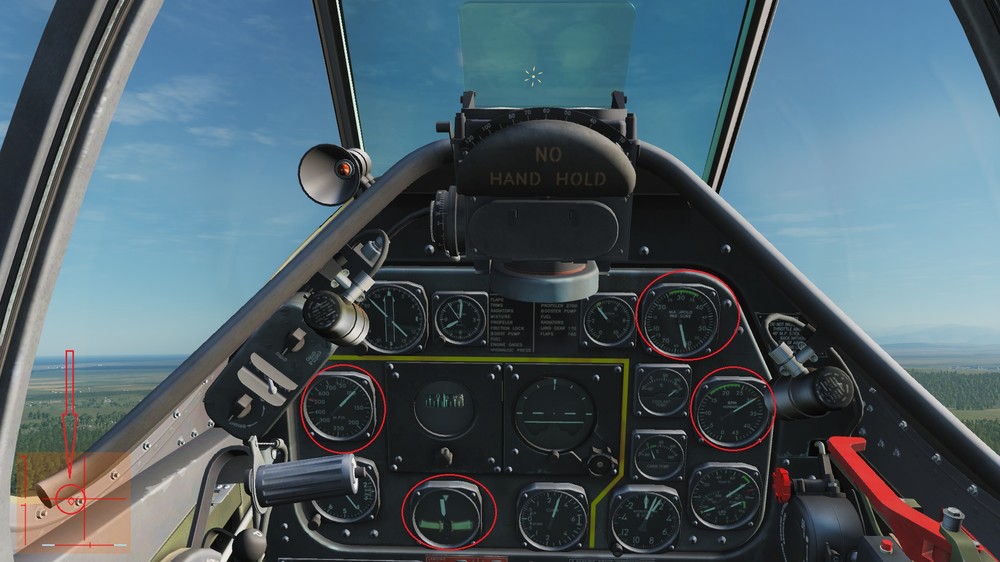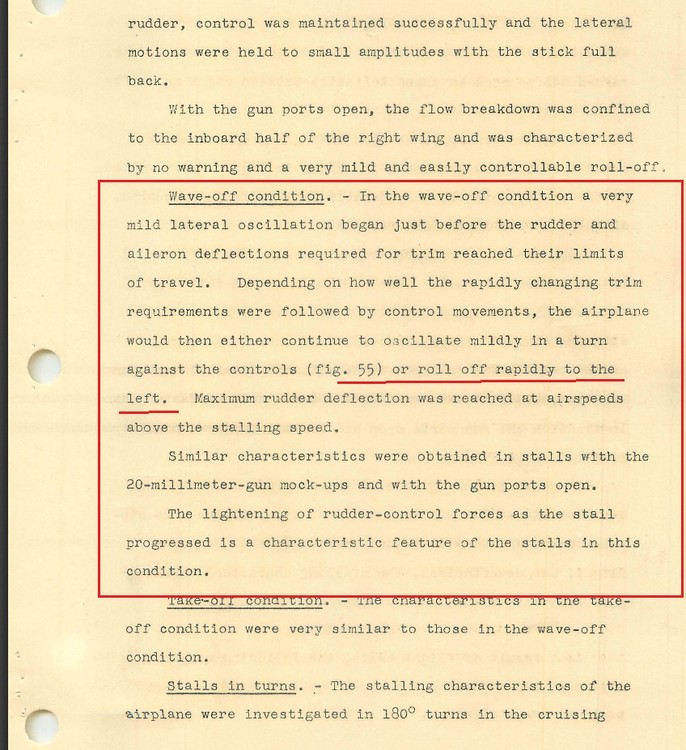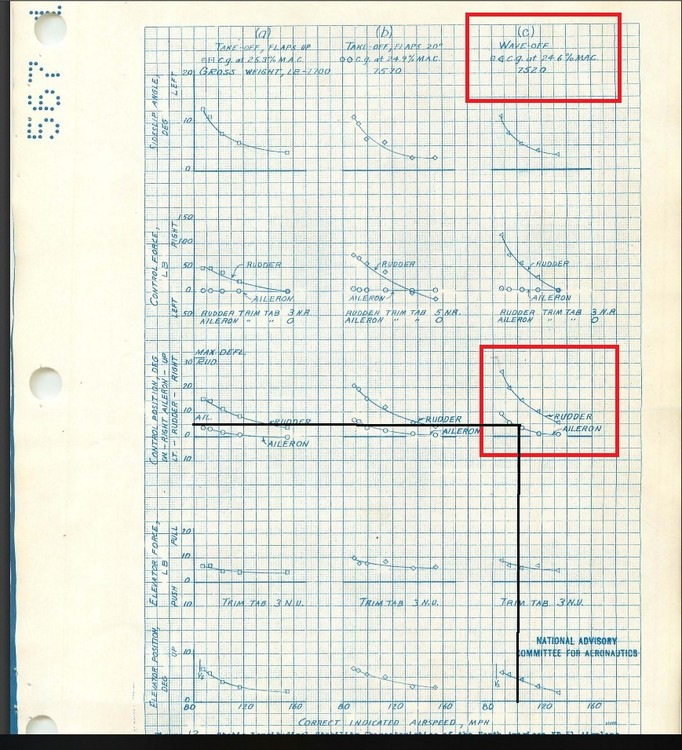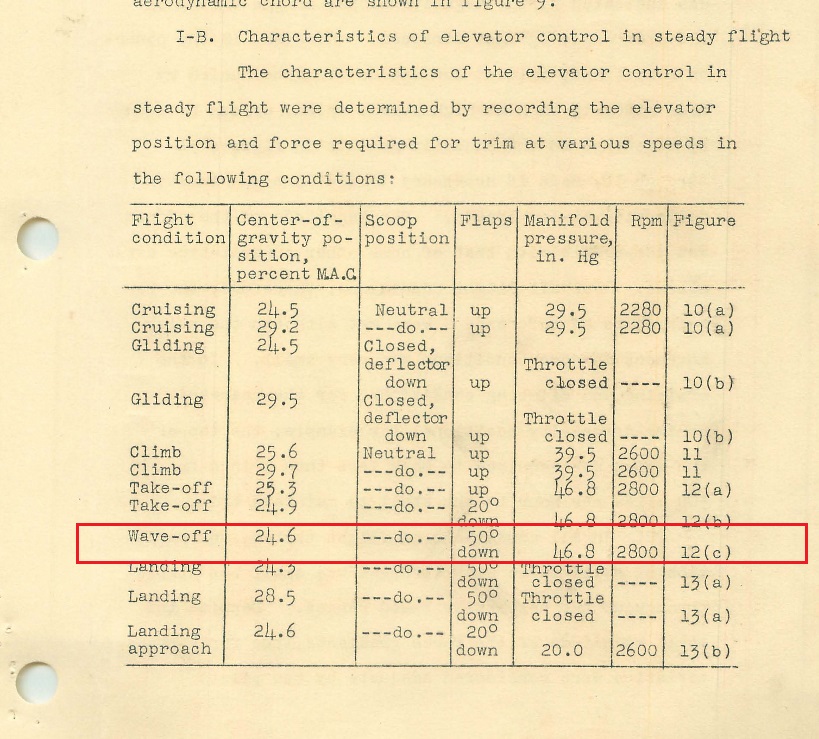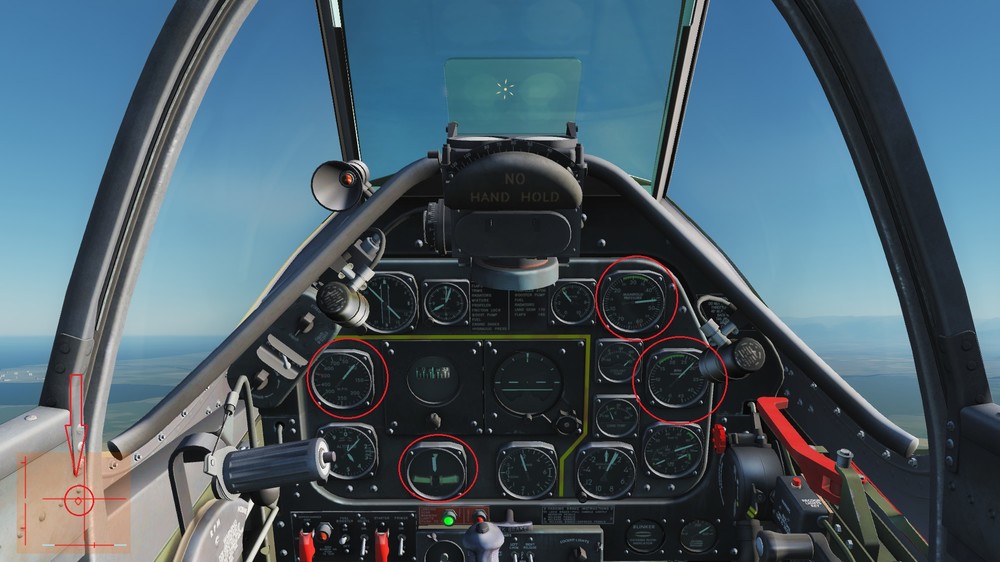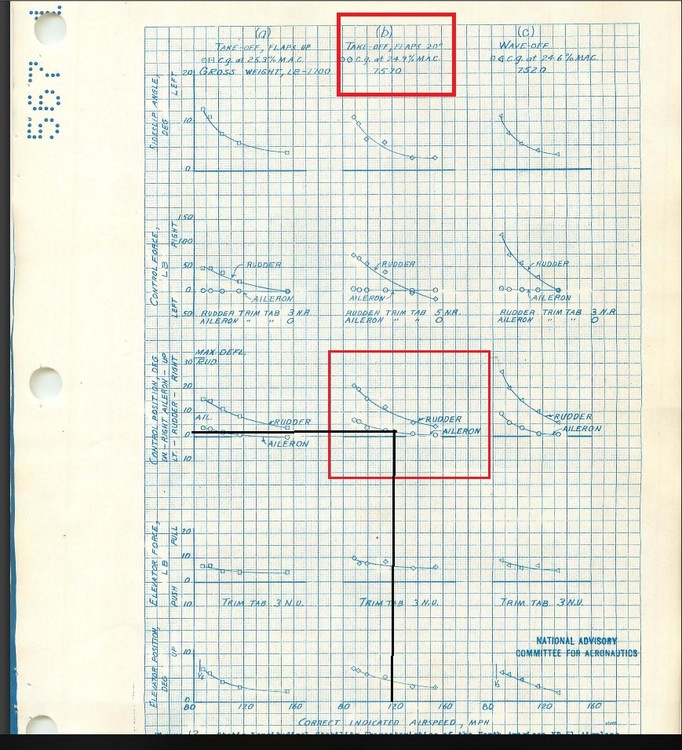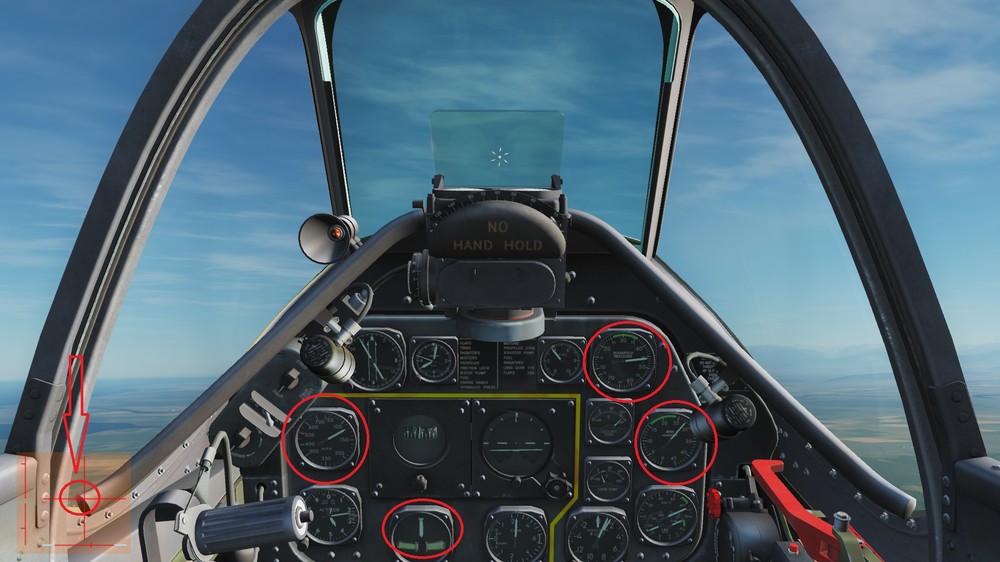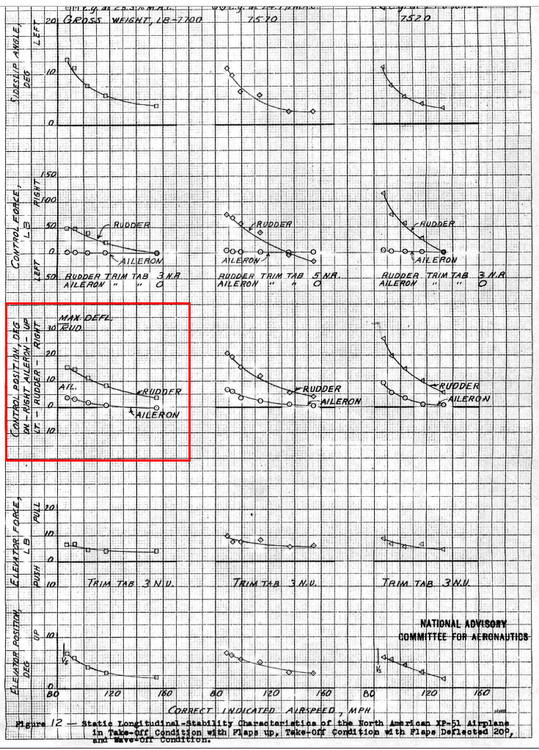

HWasp
Members-
Posts
645 -
Joined
-
Last visited
Content Type
Profiles
Forums
Events
Everything posted by HWasp
-
I think you might have misinterpreted my post. The torque is indeed modelled, BUT it corresponds to the XP-51 graphs in the flaps up config only. In the other two config (flaps 20 climb and go-around climb) there is a left stick input needed instead of the right stick (right aileron up) suggested by the graph. Here is a last screenshot with MP 61 RPM 3000, just to be sure, that more power does not solve this.
-
Here is also the report about aircraft behaviour during wave-off. In the current DCS model I did not notice the tendency to roll to the left, as the report would suggest.
-
3. Test: Wave off configuration MP 46 RPM 2800 Flaps full, Gear down, according to the table attached. In this test the FM did not comply with the graph either, results are quite similiar to the previous test with left aileron up instead of right aileron up. See attached documents and track! Fuel was balanced this time as well. P-51D_waveoff_torque.trk
-
Managed to find the whole document: https://crgis.ndc.nasa.gov/crgis/images/a/ac/Flying_Qualities_and_Stalling_Characteristics_of_North_American_XP-51_Airplane_1943.pdf And also tested the effects according to this. With flaps up and MP 46 RPM 2800, as you said, the plane behaved according to the chart, with minimal aileron input. Test 2: Flaps 20 MP 46 RPM 2800 In this test the FM did NOT comply with the chart, as left aileron up was needed instead of the right aileron up in the graph. See attached srceenshot, graph, and track. Aircraft weight was around 7600lb as requested by the document (civilian version checked). Fuel was in balance! P-51D_F20_torque.trk
-
Thank you for your intructions! I will test according to the chart you have provided previously, once I get home on saturday. On the chart I can see 3 different colunms. According to the description, the first one is take-off configuration with flaps up (the one you marked), the second is with flaps 20, and the third column is wave-off configuration. I would like to test this as well. ( 3rd row, 3rd column, can't mark it now, im on my phone) The top of the column is missing, so I will need your help here, about exact parameters, to make this valid. I would think: gear down, flaps full, full power (61/3000) climbing at 7520 lb weight. Doing this at 90Mph, according to the chart (3rd column) I will expect about 24 deg right rudder, and right aileron moving 7 degrees up. Please provide more details, if possible and/or repost the full figure. Thank you very much in advance!
-
This is the data from a previous 109 flight, with about the exact same dynamics as the one in the track. (different times though) 00:36 IAS :79 km/h / Pitch: 86 / AoA: -6,5 -stable -same --no roll left<---- | This is the area I'm on about, no tendency to roll left due to torque 00:37 IAS :60 km/h / Pitch: 83 / AoA: -10,4 -stable -same--no roll left<---- 00:38 IAS :40 km/h / Pitch: 79 / AoA: -20,1 -rotation starts 00:39 IAS :30 km/h / Pitch: 77 / AoA: -27 -rotation accelerates 00:40 IAS :20 km/h / Pitch: 72 / AoA: +121 -rotation accelerates (much faster now then TF-51) During the climb there is full right rudder only, no other strong control imputs. My point is: Why does that rotation to the left caused by the torque starts only that late? I would expect a strong tendency to rotate left around the longitudinal axis throughout the low speed climb, getting stronger, and soon unstoppable. I think there might have been a misunderstanding between us, about what I'm trying to point out, so I'm going to edit my previous posts
-
The effect that makes the aircraft roll around it's longitudinal axis is pure torque, as you say, I did not mean to disagree about that. What I was trying to point out with my posts, is that I miss this torque (trying to rotate the aircraft around it's longitudinal axis), while in the very low speed segment of the climb. What I am trying to understand is, what is the force/forces, that are able to counteract this strong torque during the final slow speed segment of the climb, where dynamic pressure is already insufficient, as you say, before the rotation about the longitudinal axis starts.
-
[quote name= For exemple: https://fr.wikipedia.org/wiki/Nord_3202 I did my graduate on this kind of plane, the axis of the engine was shifted compared to that of the fuselage, the vertical empennage was also shifted compared to the axis of the fuselage. All that to counter the reversing couple.(torque) In spite of that we had to put the rudder and the trim on the bottom right, and the thing was going left during the takeoff. In flight none of that would stop us from flying normally Still with only 240 horses. So try to imagine with 1500 horses and more? That is a very nice plane. I had my basic training with a nice taildragger as well, even though 185HP only. Good times. I really wouldn't like to start a fight about who has what flying experience, but please, keep in mind, that there might be other people around with actual flight experience.
-
Dude, are you for real? :lol: What aircraft do you fly, and how many hours did you log on warbirds to have that condescending tone? Also, how can isolating an effect to study can be a problem? What kind of messed up logic is that? I was trying to keep my posts focused and polite as much as I can, since I don't like it how all the threads about FMs turn into a throwing of ....s. And also, just to be very clear about that, I have the greatest respect for the people creating the flight models of DCS birds, especially ED's. I am aware of the great complexity of the subject, and I find the overall quality amazing. I have the best of intentions here.
-
That's a good one! I do apologize for my primitive methods. I was trying to isolate the effects caused by the propeller by getting the plane to a very low speed environment, ripping most of the legs. The thing, that seems strange to me, especially with 109, is that while it is able to remain stable, not rolling around it's longitudinal axis at a speed of 60km/h (F2) in the vertical,then, at the top of the climb, it starts to rotate along the longitudinal axis at 200 to 250 degrees/sec (yes I have measured that with a stopwatch). I am trying to talk about that strange 3 seconds, when the plane is almost stopped in the air. First it does not roll around the longitudinal axis, then it starts to roll with great force. Please have a look at the attached track between 00:27 and 00:30, and if you have some more time for this, please help me understand, what is happening there, and why. BF109 Test.trk
-
What I see here after these experiments is the following: - Torque is modelled BUT for some reason the roll tendencies around the longitudinal axis are very weak or non existent even in the low speed, low dynamic pressure regime up until the point the aircraft exceeds stall AoA, then there is unstoppable rotation along the longitudinal axis due to torque - Torque is unique to the aircraft (Bf-109 spins faster than TF-51). I think, we could agree on, that the forces acting on the airframe by the relative flow at speeds of 50 km/h is quite low (whatever is the direction). Also the difference in speed is very low between between the torque roll and no torque roll range (60 to 40 km/h, and 80 to 50) Both the TF-51 and the Bf-109 seems to behave following the exact same pattern, even though they are quite different beasts. Altogether it seems: Stall AoA acts as a trigger: If AoA > stall---> torque roll, if AoA<stall--->no torque roll Edit: The problem: why is there no tendency to rotate left around the longitudinal axis before stall AoA is reached in the very low dynamic pressure regime. Writing an effective bug report about this will be quite difficult.... IF there is a bug at all...
-
I was interested, how the Bf-109 would fare in the same experiment: Vertical climb 1.8 ATA prop auto (rpm 2800) (MW-50) 00:35 IAS: 98 km/h / Pitch: 87 / AoA: -4,5 - stable - very slow right roll due to full right rudder 00:36 IAS :79 km/h / Pitch: 86 / AoA: -6,5 -stable -same 00:37 IAS :60 km/h / Pitch: 83 / AoA: -10,4 -stable -same 00:38 IAS :40 km/h / Pitch: 79 / AoA: -20,1 -rotation starts 00:39 IAS :30 km/h / Pitch: 77 / AoA: -27 -rotation accelerates 00:40 IAS :20 km/h / Pitch: 72 / AoA: +121 -rotation accelerates (much faster now then TF-51) 00:42 IAS :-46 km/h / Pitch: 65 / AoA: -148 -rotation around twice as fast as TF-51 very roughly 220 deg/second Rotation at twice TF-51 speed continues, falling backward until nose falls down at 00:48 (and white smoke from the engine), then rotation slows and stops No track this time, but view counts are low anyway...
-
I did not post that sentence, how is my name there in your quote? :huh:
-
Trying to narrow this down with some further unprofessional tests. See attached track. 1st vertical / power 100% prop. max rpm 00:43 - IAS: 100km/h / pitch: 76 / AoA: 10,2 --- stable 00:45 - IAS : 80km/h / pitch: 73 / AoA: 8,8 ----stable 00:47 - IAS: 52 km/h / pitch: 65 / AoA: 15,2 ---stable At this point as AoA goes above 20 rotation to the left starts 00:50 - IAS: -46km/h / pitch 74 / AoA -106 --- continous rotation to the left approx 100-180 deg/second (did not measure that) 00:52 - IAS: -47km/h / pitch 66 / AoA +178 - continous rotation to the left 00:56 - IAS: 123km/h / pitch 1 / AoA -72 - still continous rotation to the left, at this point the nose drops below the horizon 00:57 - IAS: 150km/h / pitch -30 / AoA +25 - As AoA is back in range the rotation decreases rapidly 00:58 -IAS :187 km/h / pitch -67 /AoA -1 - stable dive, rotation stopped Next vertical without engine power (throttle idle, prop min. rpm) 01:38 -IAS :58 km/h / pitch 73 /AoA 15,2 --stable 01:39 -IAS :37 km/h / pitch 72 /AoA 32,3 --stable, no roll 01:40 -IAS :28 km/h / pitch 71 /AoA 63 -- no rotation 01:42 -IAS :-65km/h / pitch 53 / AoA 123 - nose dropping, no roll, no rotation Nose dropping to stable dive I think this shows the following: -The continous rotation to the left is caused by the torque, not any other effect, being stalled or anything else (we knew that of course) -Being in the 50 km/h speed range, basically zero speed, the rotation due to the torque starts only as the AoA increases above stall AoA. Pleas do watch the track and excuse my bad flying. TF-51 tailslide Test.trk
-
-
Next Test: The go around after a bounced landing, that should kill me. As source here is real vintage P-51B instructional video: According to this (27:40) I should EASE the throttle forward in case of a low speed, high AoA go around following a bounced landing or a crash is likely. In the track I have slammed the throttle full open (prop forward) at 100 after intentional bounced landing, and the plane was still almost fully controllable. I was about to test it again, but sudden engine failure has made that a full stop landing instead. :) I did the same with the 109, terrible approach, bounced landing, slam throttle (prop at 12:00) and very little effect. TF-51 landing go around Test.trk
-
Aileron input does not matter in that sitaution, since there is almost no airflow, and it is outside of the flow generated by the prop. But there was no aileron input anyway. The main idea is to get the aircraft into a situation, where it is more or less free from any other aerodynamic effects, and then, unleash the torque.
-
I didn't tell you any conclusion, because I wanted you to watch the track :) I think, that in this particular situation there is plenty of torque, especially with the 109, but I am not a warbird expert by any means. Here are the other tracks I have just made with the 109 and the Spit, using the same method, although I could not firewall the throttle in the 109 as it would kill the engine instantly for some reason, so there is some more torque left in that machine... BF-109 Torque Test.trk Spitfire Torque Test.trk
-
Hello guys! I have decided to test the torque effect, in close to zero speed conditions on the top of a vertical climb. Track is attached! - during climb throttle was idle - at close to zero speed throttle was slammed to max. - no control input was made until the plane has stabilized itself in the following dive. It's fun, so Bf-109 and Spitfire will follow soon :) TF-51 Torque Test.trk
-
I think the bug you have found is not related to the flight model, but instead the fuel system when using unlimited fuel. Having watched your track, where you fly around testing max AoA with unlimited fuel, looking at the fuel gauge, I have noticed that at around 01:10 into the track your fuel magically changes from 1200kg-ish to 2100 kg. That seems to be the cause of the instant CG shift. I have tested the behaviour with normal limited fuel, when there is no bug, and the CG really, noticeably changes as the fuel gradually drops from 2100kg to 1000kg. The effect is smooth and proportionate to the change of fuel. Again, my conclusion: The FM is not bugged, the fuel system has a bug, when using unlimited fuel (magic inflight refueling) I do not understand what your second track, where you land the plane is supposed to show us.... :)
-
Great news! Thank you! :)
-
I have just added a track with the latest patch to the original post. It is the instant action mission, and showcases the problem well. Please have a look.
-
You may be right, but since they have decided to develop two versions, very wisely, you will have the option to fly it with SPO-10 and no CM. Exactly!
-
I am extremely happy about the Flogger, it will be a day 1 pre-purchase for me, whenever available! I don't think there is a reason to argue here about different versions, since it is clear, that the developer has made a very clever choice by modelling a capable sub-version. SPO-15 and CM are great news! (Of course, not everybody needs it, a real soviet jedi pilot feels the radar emissions and defeats any opponent through pure geometry :lol: )

